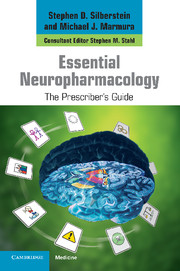Book contents
- Frontmatter
- Contents
- Introduction
- List of icons
- Acknowledgements
- 1 Acetazolamide
- 2 Almotriptan
- 3 Alteplase
- 4 Amantadine
- 5 Amitriptyline
- 6 Apomorphine
- 7 Armodafinil
- 8 Aspirin (acetylsalicylic acid)
- 9 Azathioprine
- 10 Baclofen
- 11 Benztropine
- 12 Botulinum toxin type A
- 13 Botulinum toxin type B
- 14 Bromocriptine
- 15 Carbamazepine
- 16 Carbidopa/levodopa
- 17 Carisoprodol
- 18 Chlorpromazine
- 19 Clonazepam
- 20 Clonidine
- 21 Clopidogrel
- 22 Clozapine
- 23 Cyclobenzaprine
- 24 Cyclophosphamide
- 25 Cyclosporine
- 26 Cyproheptadine
- 27 Dantrolene
- 28 3,4-Diaminopyridine
- 29 Diazepam
- 30 Dihydroergotamine
- 31 Dipyridamole and aspirin
- 32 Donepezil
- 33 Droperidol
- 34 Duloxetine
- 35 Edrophonium
- 36 Eletriptan
- 37 Entacapone
- 38 Ethosuximide
- 39 Felbamate
- 40 Flunarizine
- 41 Fluoxetine
- 42 Frovatriptan
- 43 Gabapentin
- 44 Galantamine
- 45 Glatiramer acetate
- 46 Guanfacine
- 47 Guanidine hydrochloride
- 48 Haloperidol
- 49 Heparin
- 50 Immune globulin intravenous (IGIV)
- 51 Indomethacin
- 52 Interferon-beta
- 53 Lacosamide
- 54 Lamotrigine
- 55 Levetiracetam
- 56 Lithium
- 57 Mannitol
- 58 Meclizine
- 59 Memantine
- 60 Metaxalone
- 61 Methocarbamol
- 62 Methotrexate
- 63 Methylergonovine
- 64 Methysergide
- 65 Metoclopramide
- 66 Mexiletine
- 67 Mitoxantrone
- 68 Modafinil
- 69 Mycophenolate mofetil
- 70 Naratriptan
- 71 Natalizumab
- 72 Nimodipine
- 73 Nortriptyline
- 74 Oxcarbazepine
- 75 Penicillamine
- 76 Phenobarbital
- 77 Phenytoin
- 78 Pizotifen
- 79 Pramipexole
- 80 Prednisone
- 81 Pregabalin
- 82 Primidone
- 83 Prochlorperazine
- 84 Propranolol
- 85 Pyridostigmine
- 86 Quetiapine
- 87 Quinine sulfate
- 88 Rasagiline
- 89 Reserpine
- 90 Riluzole
- 91 Rituximab
- 92 Rivastigmine
- 93 Rizatriptan
- 94 Ropinirole
- 95 Rufinamide
- 96 Selegiline
- 97 Sumatriptan
- 98 Tetrabenazine
- 99 Tiagabine
- 100 Timolol
- 101 Tizanidine
- 102 Topiramate
- 103 Trientine hydrochloride
- 104 Trihexyphenidyl
- 105 Valproic acid
- 106 Venlafaxine
- 107 Verapamil
- 108 Vigabatrin
- 109 Warfarin
- 110 Zolmitriptan
- 111 Zonisamide
- List of abbreviations
- Index by drug name
- Index by use
- Index by class
Introduction
- Frontmatter
- Contents
- Introduction
- List of icons
- Acknowledgements
- 1 Acetazolamide
- 2 Almotriptan
- 3 Alteplase
- 4 Amantadine
- 5 Amitriptyline
- 6 Apomorphine
- 7 Armodafinil
- 8 Aspirin (acetylsalicylic acid)
- 9 Azathioprine
- 10 Baclofen
- 11 Benztropine
- 12 Botulinum toxin type A
- 13 Botulinum toxin type B
- 14 Bromocriptine
- 15 Carbamazepine
- 16 Carbidopa/levodopa
- 17 Carisoprodol
- 18 Chlorpromazine
- 19 Clonazepam
- 20 Clonidine
- 21 Clopidogrel
- 22 Clozapine
- 23 Cyclobenzaprine
- 24 Cyclophosphamide
- 25 Cyclosporine
- 26 Cyproheptadine
- 27 Dantrolene
- 28 3,4-Diaminopyridine
- 29 Diazepam
- 30 Dihydroergotamine
- 31 Dipyridamole and aspirin
- 32 Donepezil
- 33 Droperidol
- 34 Duloxetine
- 35 Edrophonium
- 36 Eletriptan
- 37 Entacapone
- 38 Ethosuximide
- 39 Felbamate
- 40 Flunarizine
- 41 Fluoxetine
- 42 Frovatriptan
- 43 Gabapentin
- 44 Galantamine
- 45 Glatiramer acetate
- 46 Guanfacine
- 47 Guanidine hydrochloride
- 48 Haloperidol
- 49 Heparin
- 50 Immune globulin intravenous (IGIV)
- 51 Indomethacin
- 52 Interferon-beta
- 53 Lacosamide
- 54 Lamotrigine
- 55 Levetiracetam
- 56 Lithium
- 57 Mannitol
- 58 Meclizine
- 59 Memantine
- 60 Metaxalone
- 61 Methocarbamol
- 62 Methotrexate
- 63 Methylergonovine
- 64 Methysergide
- 65 Metoclopramide
- 66 Mexiletine
- 67 Mitoxantrone
- 68 Modafinil
- 69 Mycophenolate mofetil
- 70 Naratriptan
- 71 Natalizumab
- 72 Nimodipine
- 73 Nortriptyline
- 74 Oxcarbazepine
- 75 Penicillamine
- 76 Phenobarbital
- 77 Phenytoin
- 78 Pizotifen
- 79 Pramipexole
- 80 Prednisone
- 81 Pregabalin
- 82 Primidone
- 83 Prochlorperazine
- 84 Propranolol
- 85 Pyridostigmine
- 86 Quetiapine
- 87 Quinine sulfate
- 88 Rasagiline
- 89 Reserpine
- 90 Riluzole
- 91 Rituximab
- 92 Rivastigmine
- 93 Rizatriptan
- 94 Ropinirole
- 95 Rufinamide
- 96 Selegiline
- 97 Sumatriptan
- 98 Tetrabenazine
- 99 Tiagabine
- 100 Timolol
- 101 Tizanidine
- 102 Topiramate
- 103 Trientine hydrochloride
- 104 Trihexyphenidyl
- 105 Valproic acid
- 106 Venlafaxine
- 107 Verapamil
- 108 Vigabatrin
- 109 Warfarin
- 110 Zolmitriptan
- 111 Zonisamide
- List of abbreviations
- Index by drug name
- Index by use
- Index by class
Summary
Neurology is the final frontier of medicine, and we are starting to better understand disorders of the central and peripheral nervous system. In the past few decades, we have become increasingly able to diagnose and treat patients with neurologic disorders, resulting in improvements in both their disease and their quality of life. Medication is essential, and understanding its pharmacology is an important part of taking care of patients with neurologic disorders. Despite these advances and our expertise, we still encounter patients who are refractory to the usual therapies. Due to the increasing subspecialization of neurology into fields including epilepsy, stroke, multiple sclerosis, movement disorders, neuromuscular disorders, and headache, physicians require references to guide us in their treatment. This text focuses on the common and less common medications we use in clinical practice and provides useful tips for their use.
- Type
- Chapter
- Information
- Essential NeuropharmacologyThe Prescriber's Guide, pp. ix - xPublisher: Cambridge University PressPrint publication year: 2010

